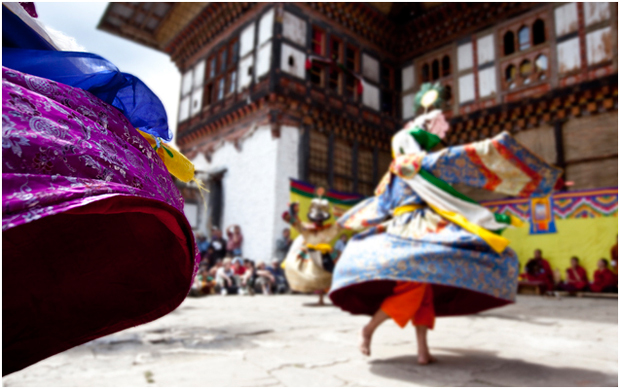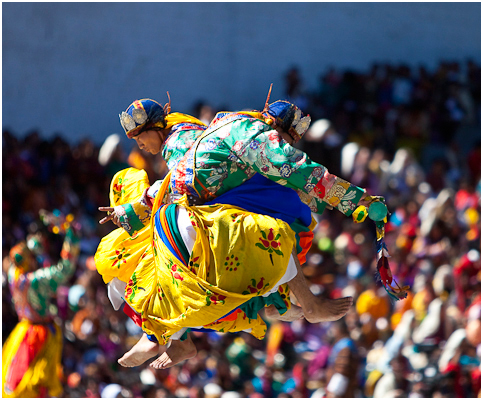The Thimpu Tsechu and the Thangbi Mani Festivals
Veteran Adventurer and Photographer Paul A.Teolis and his experience at the Thimpu Tsechu and the Thangbi Mani religious festivals in Bhutan
Veteran Adventurer, Photographer and personal friend Paul Teolis journeyed through Bhutan where he attended and photographed the Thimpu Tsechu and the Thangbi Mani religious festivals. Photos and text by Paul A. Teolis.
Hearing the familiar sound of the Tibetan Shawm, a horn-like instrument common in Buddhist ceremonies; I chuckled when I turned to see it was actually the ring-tone from a young monk’s cell phone.”

Bhutanese call their country Druk Yul, which means Land of the Thunder Dragon. For me, Bhutan is my Shangri-La!
Twice in less than twelve months I found myself photographing in this remote Himalayan Kingdom. It would be October this time, not December like before, and that meant rice fields would be painting the countryside a rich hue of green. Eighteen days would allow me to travel to the less-visited eastern region of the country where farmers and monks abound and tourists are a rare sight. My prize this trip would be to attend two religious festivals: the Thimpu Tsechu and the Thangbi Mani in the central province of Bumthang.
The Thimpu Tsechu festival is one the country’s largest and most auspicious festivals honouring Guru Rinpoche who brought Buddism to Bhutan in the 8th century. Held at the Tashichho Dzong, home to government ministries and the monk body, the spectacle is not just colorful costumes and masked performers dancing stories of their ancient folklore traditions; the locals come decked out in their finest silk clothes and jewelry; celebrating their rich Buddhist heritage. It’s part carnival, part social spectacle, and total sensory overload.

My first five days in Bhutan were pretty much retracing a route the majority of tourists take; bound by Paro, Thimpu, Wangdue and Punaka.
In these destinations alone, there are multiple Dzongs and monasteries to visit, each with its own significance in the country’s evolution. Originally fortresses, many Dzongs are built at strategic points and date back to the 15th and 16th century, while some monasteries, particularly in central Bhutan, were built in the 7th century. Prayer wheels, large and small, are a common sight and the interior walls within the courtyard and temples are elaborately painted, illustrating stories of Buddhist gods and deities.

The great thing about travel in Bhutan is that one is never disappointed with the accommodations. There is one standard of hotel here, which is more than comfortable for an adventure traveler. A soft bed and hot water is luxurious for me - here I feel like a king!
The local cuisine is a blend of Indian, Chinese and western, so meat-eaters and vegetarians are all more than happy. Try the local red rice and those chilies you see drying outside in the sun everywhere in the country on anything that has a flat surface (the road and most roofs), are a major ingredient in their traditional chili-cheese dish. A five-alarm spice alert! With a cold Druk Beer (8%) it’s like reaching nirvana.
Everything felt familiar to me this point in my trip, about five days in (especially the druk beer), but upon arriving in Bumthang, in the central region of the country, I was officially in new territory.
Contrasting the Thimpu festival was the smaller and more intimate Thangbi Mani Festival, held on the new moon in October according the Buddhist calendar, and taking place in the village of Thangbi.

Where the national festival had thousands of onlookers, here there were hundreds. Not difficult to get a front row view in the Thangbi monastery courtyard, which was about the size of four tennis courts. There was much more of an intimate feel here, as locals and tourists from all around gathered for three days of music, dance and Bhutanese folklore.
Local village girls sing between the various mask dances, while stories were told through the Black Hat Dance, the dance of the Stag and the Drum Dance. Richly colored costumes ebb and flow with the motion of the dancers and bright and colorful masks depicting gods, demons and animals would hypnotize any onlooker. In my mind, a central focus of this wondrous festival was the festival elder who presided over the opening of the Thangbi Mani and blessing during the fire purification with a Tibetan bell in one hand and ritual septor in the other. He possessed a face that showed his years and was rich with texture, in which each wrinkle undoubtly had a story to tell from his long life here.
For many, Bumthang is the end of their trip. But, for me, the journey would continue further into the heart of the country, along the road from Jakar to Mongar and to the far reaches of Trashigang in the east.
To see more of Paul’s work visit fieldandscreen.com.
Getting There
G Adventures runs a number of departures in Bhutan encompassing a wide range of departure dates and activities to cater to different tastes. We’re thrilled at the prospect of showing you this big blue planet of ours — check out our small group trips here.






























